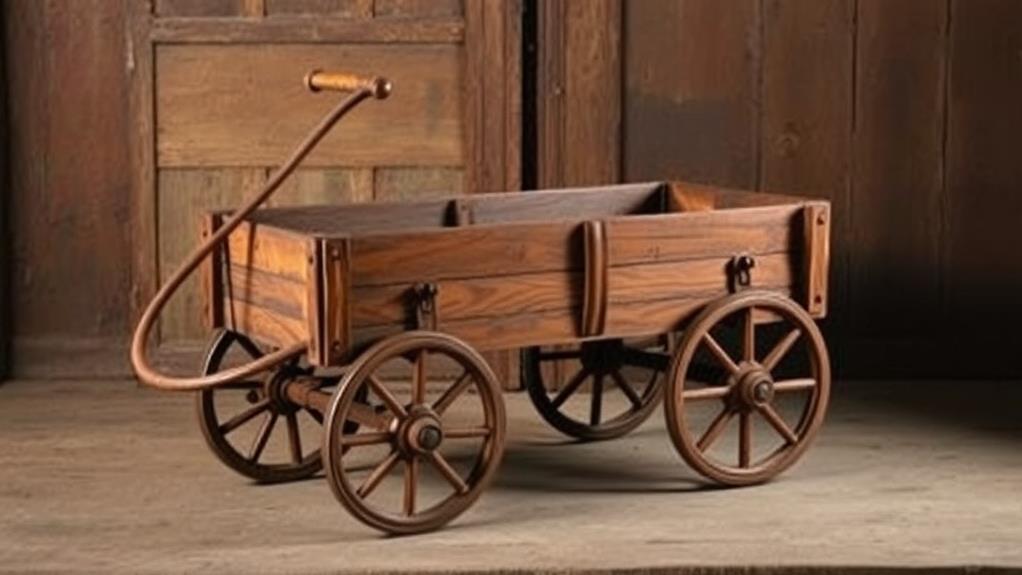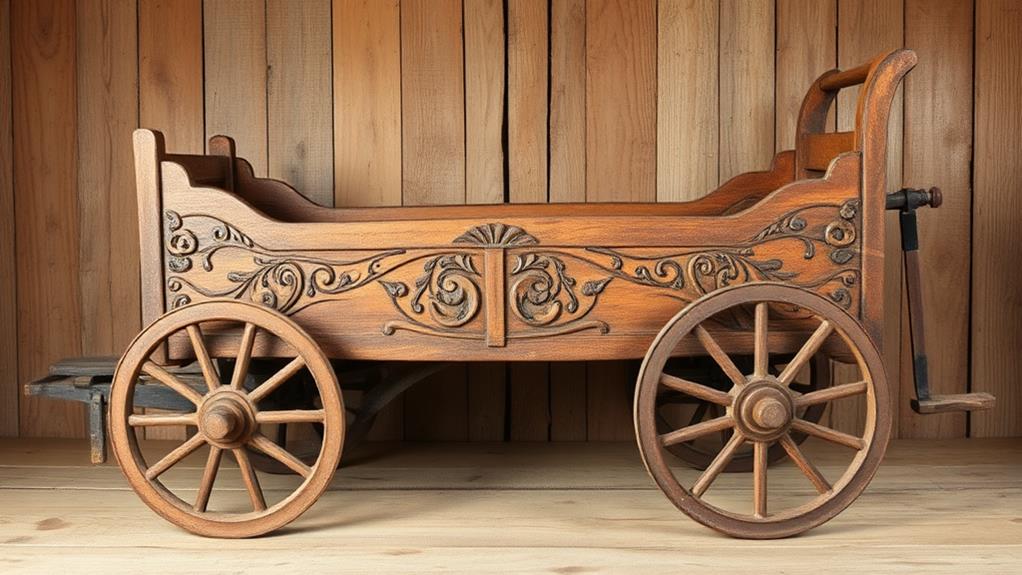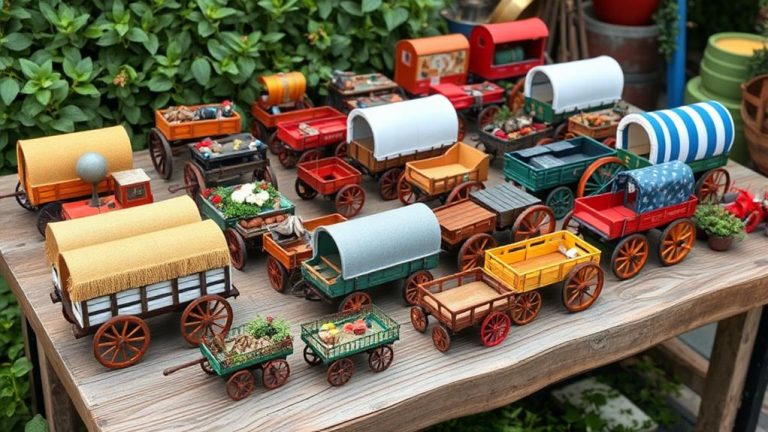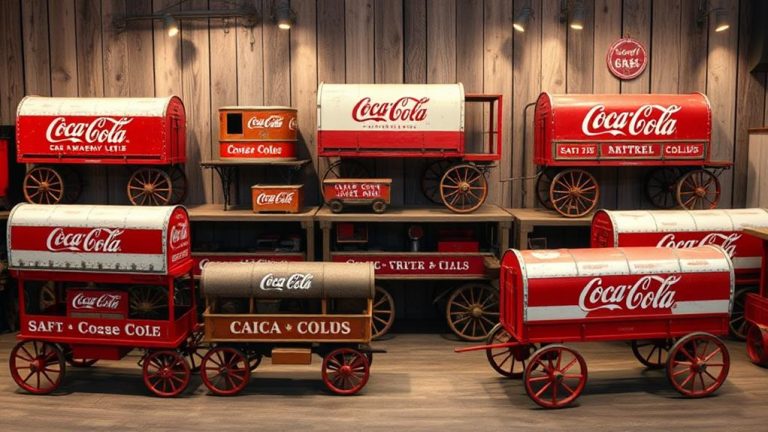To identify antique wooden pull wagons, you'll want to examine several key features. Start with the craftsmanship; look for traditional joinery techniques like mortise and tenon joints. The wood type is essential, as hardwoods typically signal better durability. Inspect wheel design; larger, wider wheels often indicate functionality over rugged terrains. Keep an eye on hardware quality and markings, as they help reveal the wagon's history. Furthermore, consider the paint and finish, which can show age and restoration efforts. Finally, dimensions and proportions can hint at their intended use. There's much more to uncover in comprehending these fascinating pieces.
Age and Craftsmanship

The age and craftsmanship of antique wooden pull wagons reveal a fascinating intersection of utility and artistry. When you investigate these pieces, you'll uncover their historical significance, which reflects the daily lives and needs of past communities. Each wagon tells a story, capturing the essence of the time it was crafted and the purpose it served.
You might notice that regional styles greatly influence the design of these wagons. For instance, a wagon from the Midwest may feature more robust construction, designed to withstand rough terrain, whereas a coastal version might exhibit lighter, more intricate detailing, suited for transporting goods to markets. These stylistic choices not only showcase the skill of the craftsmen but also reveal the cultural values and necessities of specific areas.
The construction techniques employed, like mortise and tenon joints or hand-carved embellishments, offer insight into the artisan's knowledge and the tools available at the time. As you explore the age and craftsmanship of these antique wooden pull wagons, you'll appreciate not just their functionality, but also the artistry that embodies a freedom of expression tied to the historical context in which they were created.
Wood Type and Grain
Choosing the right wood type for antique wooden pull wagons greatly impacts their durability and aesthetic appeal. You'll want to scrutinize the wood characteristics closely, as different types offer varying strengths and visual traits. Hardwoods like oak and maple are often preferred for their resilience, whereas softer woods like pine may show more wear over time.
When evaluating grain patterns, look for unique features that indicate age and craftsmanship. For instance, tight, straight grain lines typically signify high-quality wood, while broader, irregular patterns might suggest a more rustic charm. Furthermore, the presence of knots can add character but may likewise indicate potential weaknesses in the structure.
Pay attention to the color and finish of the wood as well. Rich, deep hues often reveal the natural aging process, while lighter shades may hint at restoration or repair. Remember, the combination of wood type and grain patterns contributes to the wagon's historical value and reflects the maker's intention and the era it represents. By comprehending these nuances, you can more confidently identify and appreciate the unique qualities of antique wooden pull wagons.
Wheel Design and Size

When evaluating antique wooden pull wagons, the wheel design and size are essential for comprehending their functionality and longevity. You'll want to take into account the material used, as it directly impacts durability and performance over time. Moreover, the diameter and width of the wheels play a significant role in how well the wagon navigates various terrains.
Wheel Material and Durability
Many antique wooden pull wagons feature wheels crafted from a variety of materials, each contributing to the overall durability and functionality of the wagon. Grasping the composition can help you appreciate their historical significance and assist in wheel maintenance.
Here are four common materials used in antique wagon wheels:
- Wood: Often made from hardwoods like oak or maple, wooden wheels provide a classic look but require diligent wheel maintenance to prevent rot and wear.
- Iron: Iron rims or hubs improve durability, especially for wagons used on rugged terrain. They resist wear and can withstand considerable weight.
- Rubber: Some later models incorporate rubber for better traction and shock absorption. These wheels may show signs of aging, impacting overall durability.
- Steel: Steel wheels are less common but offer exceptional strength. Their ability to endure heavy loads makes them ideal for specific applications.
Diameter and Width Measurements
Comprehension of wheel material and durability lays the groundwork for appreciating how diameter and width measurements influence the overall design and performance of antique wooden pull wagons. The diameter significance of a wheel directly affects its ability to navigate different terrains. Larger diameter wheels provide better traction and ease of movement over rough surfaces, whereas smaller ones can maneuver more easily in tight spaces.
You'll want to pay attention to the width variations as well. Wider wheels distribute weight more evenly, reducing the likelihood of sinking into soft ground, which is particularly vital for outdoor use. Conversely, narrower wheels can improve speed on hard surfaces but may compromise stability.
When evaluating an antique wooden pull wagon, examine the balance between these measurements. A well-designed wagon will harmonize wheel diameter and width, optimizing both functionality and aesthetic appeal. Grasping these dimensions not only informs you about the wagon's intended use but additionally deepens your appreciation of the craftsmanship involved. Fundamentally, the interplay of diameter and width shapes the experience of freedom that these charming antiques can offer.
Hardware and Fastenings
Although the charm of antique wooden pull wagons often lies in their craftsmanship, the hardware and fastenings used in their construction are equally significant for both functionality and historical value. Comprehending the fastening types and hardware materials can help you identify the authenticity and era of the wagon.
Here are four key aspects to reflect upon:
- Metal Fastenings: Look for iron or brass screws and nails, which were commonly used in the 19th century. Their oxidation might indicate age and usage.
- Rivets and Plates: Some wagons feature decorative or functional rivets and metal plates, which can reveal manufacturing techniques and regional styles.
- Hinges and Latches: Examine the quality and design of hinges and latches. Older models often have hand-forged components, showcasing the craftsmanship of the time.
- Wooden Components: Contemplate how the hardware is integrated with the wooden elements. Mortise and tenon joints were typical, indicating a higher level of craftsmanship.
Paint and Finish

The allure of antique wooden pull wagons is often augmented by their paint and finish, which both protect the wood and represent the aesthetic preferences of their era. When examining these wagons, you'll want to reflect on the paint types used. Early examples frequently feature milk paint or oil-based paints, which were common in rural settings and often had a matte finish. Conversely, later models might showcase brighter, more durable enamel paints that reflect a shift in direction to industrial aesthetics.
The finish techniques are equally important. Look for natural finishes like shellac or varnish, which improve the grain and provide a warm glow, indicative of craftsmanship from the past. You might additionally encounter painted designs—floral patterns or geometric shapes—that reveal the owner's personality and the cultural influences of the time.
Pay attention to wear and patina, too. Authentic antique finishes will show signs of age, whereas modern repaints can often appear too uniform or glossy, detracting from their historical value. By carefully analyzing paint types and finish techniques, you can gain deeper insights into the wagon's age and provenance, enriching your appreciation of these charming pieces of history.
Markings and Stamps
When examining antique wooden pull wagons, the presence of maker's marks can provide critical insights into their provenance and craftsmanship. These markings not just help identify the manufacturer but additionally play a significant role in determining the wagon's age and authenticity. By comprehending how to interpret these stamps, you can deepen your appreciation for these historical pieces and their unique stories.
Maker's Mark Significance
Maker's marks on antique wooden pull wagons serve as vital indicators of authenticity and craftsmanship, providing insight into the maker's identity and the era of production. Comprehending maker's mark history is fundamental for enthusiasts and collectors alike. These marks not merely confirm a wagon's legitimacy but additionally reveal the quality of craftsmanship behind it.
When identifying a maker's mark, consider the following aspects:
- Design and Style: Look for unique symbols or initials that reflect the maker's signature style, often indicative of their region or period.
- Material and Technique: The method used to create the mark—be it stamped, carved, or painted—can provide clues about the manufacturing techniques of the time.
- Historical Context: Research the maker's background; knowing their era can help situate the wagon within a specific historical narrative.
- Rarity and Value: Certain makers are more sought after, making their marks more valuable; grasping this can inform your appraisal of the wagon.
Age Identification Techniques
Identifying the age of antique wooden pull wagons hinges considerably on the markings and stamps present on the piece. These identifiers serve as a direct link to the wagon's historical context, allowing you to trace its origins and the era it represents. Look for specific symbols or manufacturer stamps that can pinpoint the production date or period. Often, the absence of these marks may indicate a later reproduction, which diminishes the piece's value.
You should likewise consider the preservation methods used on the wagon. Original finishes and patinas can provide insights into the wagon's age; a well-preserved item might have subtle signs of wear that speak to its usage over time. Conversely, overzealous restoration can obscure important markings or change the wagon's character entirely.
Dimensions and Proportions

The elegance of antique wooden pull wagons often lies in their dimensions and proportions, which reflect a blend of functionality and aesthetic appeal. When evaluating these wagons, a careful scale comparison and proportional analysis can reveal their historical significance and craftsmanship. Here are four key dimensions to take into account:
- Overall Length: Typically ranging from 30 to 48 inches, this dimension affects both usability and transportability.
- Width: A width of 18 to 24 inches not just influences stability but additionally provides insight into the wagon's intended purpose—be it for hauling goods or children.
- Height of Sides: The side height can vary between 6 to 12 inches; this affects the capacity and the visual balance of the wagon.
- Wheel Diameter: Ranging from 8 to 14 inches, larger wheels are often indicative of a wagon designed for rugged terrains, showcasing engineering adaptability.
Design Style and Features
When you examine antique wooden pull wagons, the construction materials and techniques reveal much about their craftsmanship and longevity. You'll notice that wheel design variations considerably impact both functionality and aesthetic appeal, whereas decorative elements and patterns add unique character to each piece. Comprehending these aspects improves your appreciation for the artistry and practical considerations behind these charming antiques.
Construction Materials and Techniques
Antique wooden pull wagons often showcase a variety of construction materials and techniques that reflect the craftsmanship of their time. When examining these wagons, you can identify key features that reveal their age and workmanship.
- Joinery Techniques: Look for traditional joinery methods, such as mortise and tenon joints, which indicate skilled craftsmanship. These techniques not only improve durability but additionally showcase the artisan's expertise.
- Wood Aging: The type of wood used and its aging process can tell you a lot about the wagon's history. Older wagons often use hardwoods like oak or maple, which age beautifully and develop a rich patina.
- Finish: Pay attention to the finish, as original varnishes or stains from the period can show signs of wear, adding character.
- Fasteners: Observe the use of hand-forged nails or screws, which were common in earlier constructions. Their unique shapes and sizes can help date the wagon.
Wheel Design Variations
Exploring wheel design variations in antique wooden pull wagons reveals a fascinating interplay of functionality and artistry. The wheels not just serve a practical purpose but additionally reflect the aesthetic preferences and technological advancements of their time.
When examining these wheel designs, you'll notice distinctive features that contribute to their historical significance. Consider the following table that outlines common wheel types:
| Wheel Type | Design Features | Historical Context |
|---|---|---|
| Spoke Wheels | Lightweight, intricate spokes | Popular in the late 19th century |
| Solid Wheels | Thick, sturdy construction | Common in early 20th century |
| Wooden Rims | Decorative, carved edges | Symbol of craftsmanship |
| Iron-Bound Wheels | Reinforced durability | Used for heavy loads |
Each design variation offers insight into the wheel aesthetics prevalent during its era. By comprehending these features, you can appreciate how wheel design not only improved performance but additionally showcased the cultural values of craftsmanship and innovation. Whether you're a collector or simply curious, recognizing these variations can deepen your appreciation for the beauty and utility of antique wooden pull wagons.
Decorative Elements and Patterns
Beyond the mechanics of wheel design, the decorative elements and patterns found on antique wooden pull wagons offer a window into the artistic sensibilities of their makers. These embellishments often reflect the cultural and personal narratives of the time, revealing much about the values and aesthetics embraced by their creators. When examining these features, consider the following aspects:
- Color Combinations: Look for lively palettes or earthy tones that indicate regional influences or personal taste.
- Symbolic Motifs: Many wagons showcase designs with specific meanings, such as floral patterns signifying growth or geometric shapes representing stability.
- Carving Techniques: Observe the intricacy of carvings; deeper, more detailed work often suggests a higher level of craftsmanship.
- Finish and Patina: The age and wear of the finish can improve the visual appeal, showing how the wagon's use has shaped its character over time.
Restoration and Alterations

When considering the restoration and alterations of antique wooden pull wagons, it's important to assess the original craftsmanship and materials used in their construction. You should approach restoration techniques thoughtfully, as these methods can greatly impact the wagon's value and authenticity. For instance, using modern adhesives or paints may compromise the original aesthetic and integrity of the piece.
Carefully evaluate the extent of any damage before deciding whether to restore or alter components. Preserving original parts is imperative; replacing them can diminish the wagon's historical significance. If alterations are necessary, opt for reversible techniques that allow you to maintain the original essence as you enhance functionality.
It's also important to document any changes you make, as this transparency can inform future owners about the wagon's history. This practice not only adds to your own comprehension but also respects the legacy of the piece. Remember, each restoration choice you make carries alteration impacts that resonate through time, reflecting your commitment to preserving history as you enjoy the freedom of ownership. Balancing restoration with respect for authenticity will eventually guarantee that your antique wooden pull wagon remains a cherished artifact for years to come.
Provenance and History
Grasping the provenance and history of your antique wooden pull wagon amplifies your appreciation of its craftsmanship and increases its value. By grasping its background, you can gauge its historical significance and the stories it carries. Here are some key aspects to reflect upon:
- Origin: Research where the wagon was made. Local craftsmen often used unique techniques that reflect regional styles.
- Ownership Records: Investigate any available documentation that traces the wagon's previous owners. This can add layers of narrative and authenticity.
- Historical Context: Reflect on the era in which your wagon was built. Knowing the social and economic conditions of that time can provide insight into its design and function.
- Provenance: Establish a clear lineage of the wagon. A well-documented history increases its value and desirability among collectors.
Frequently Asked Questions
What Materials Were Commonly Used for Pull Wagon Construction?
When exploring pull wagon construction, you'll find that various wood types, like oak, pine, and ash, were commonly used for their durability and availability. The construction techniques often involved mortise and tenon joints, ensuring strength and longevity. Each wood type contributed unique characteristics, influencing both aesthetics and functionality. Comprehending these materials can improve your appreciation for the craftsmanship involved, giving you a deeper connection to the freedom these wagons once provided.
How Can I Tell if a Wagon Is a Reproduction?
You wouldn't believe how many "authentic" wagons out there are just clever reproductions! To spot a reproduction, look for modern manufacturing methods: uniform joints, machine-cut edges, or contemporary materials. Pay attention to reproduction signs like brand labels or overly pristine finishes. If it feels too perfect, it probably is! Trust your instincts—an antique should have character, wear, and age that reveals its true story, not a glossy facade pretending to be something it's not.
Are There Specific Brands Known for Quality Antique Wagons?
When you’re exploring quality antique wagons, certain brands stand out because of their rich brand history and craftsmanship. Look for names like Radio Flyer or Little Red Wagon; they’ve maintained their appeal through collectible trends over the decades. Comprehending these brands’ unique attributes helps you identify authentic pieces. It’s essential to research their production years and styles, as this knowledge empowers you to make informed decisions in your quest for freedom in collecting. Examining details such as paint finishes, wheel construction, and handle designs can further authenticate your find. Additionally, some collectors specialize in miniature display wagons, which replicate classic designs on a smaller scale and make excellent additions to any collection. Whether you’re after full-sized models or compact versions, understanding their historical significance enhances your appreciation and collecting experience.
How Do Weather Conditions Affect Wooden Wagons' Preservation?
Weather conditions play an essential role in preserving wooden wagons. High humidity can cause wood to swell and warp, whereas low humidity might lead to cracks and splintering. Temperature fluctuations further exacerbate these issues, as rapid changes can stress the material. You'll want to store your wagon in a stable environment, ideally away from direct sunlight and extreme temperatures, to maintain its integrity and prolong its life. Proper care guarantees freedom from deterioration.
What Is the Average Market Value for Antique Pull Wagons?
When considering the average market value for antique pull wagons, you'll find it fluctuates based on market trends and auction prices. Typically, you're looking at values ranging from a few hundred to several thousand dollars, depending on condition and rarity. It's crucial to research recent sales to gauge current demand. Engaging with collectors or attending auctions can provide insights into pricing dynamics, helping you make informed decisions when buying or selling.




